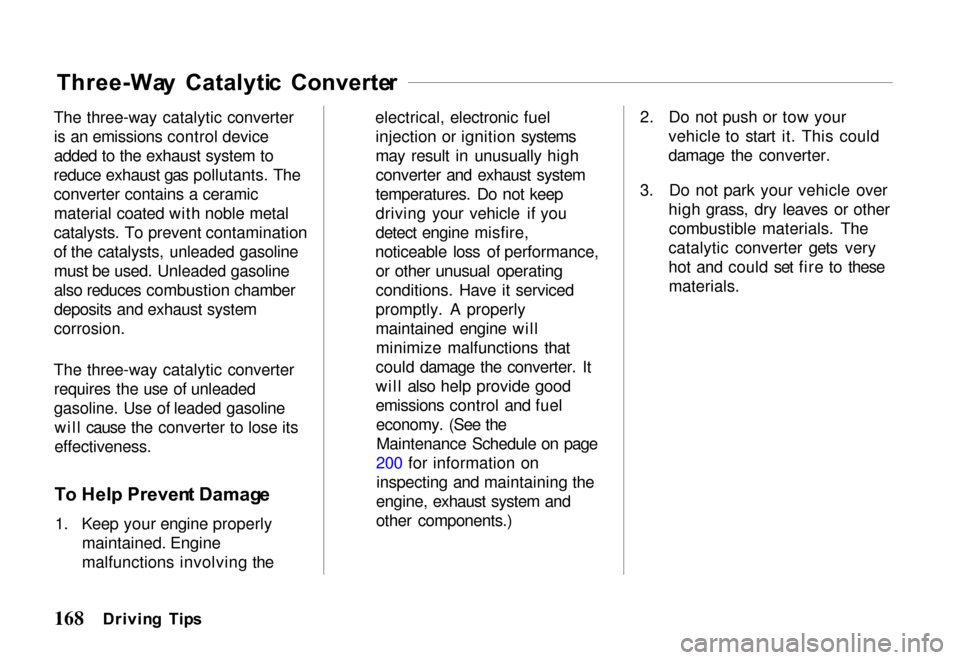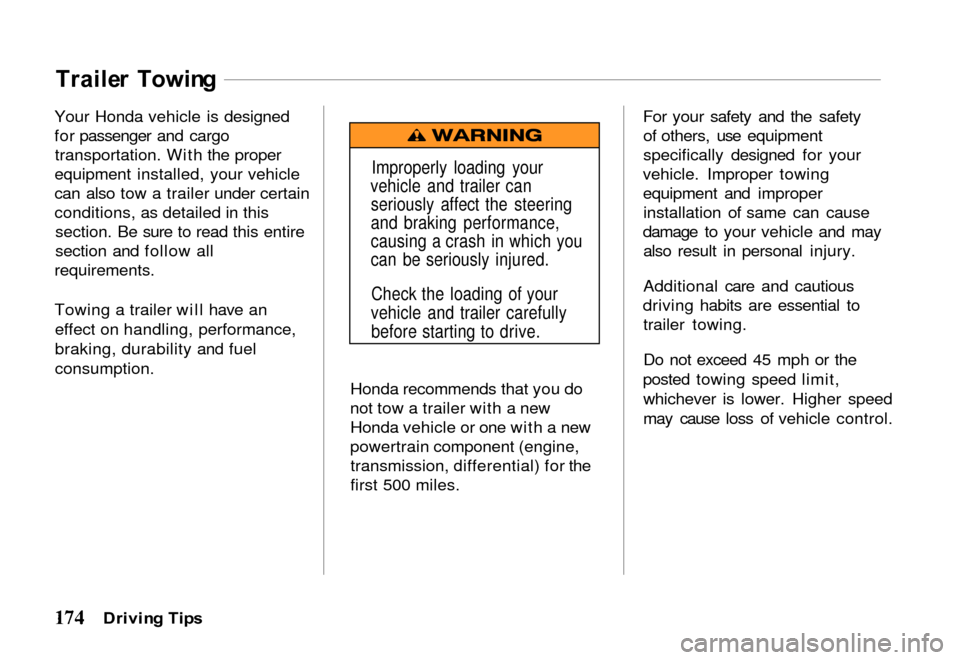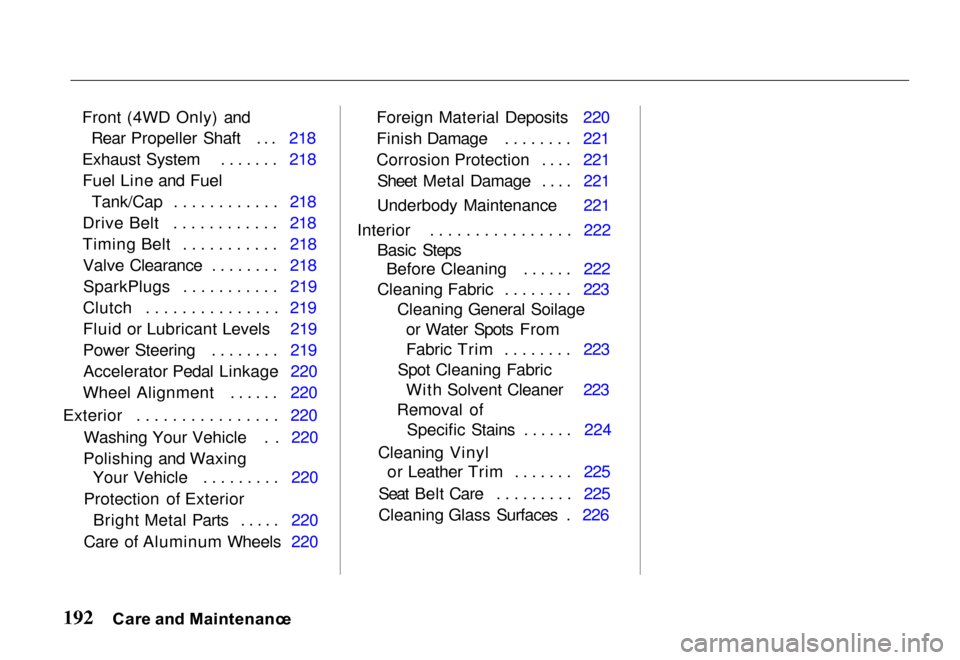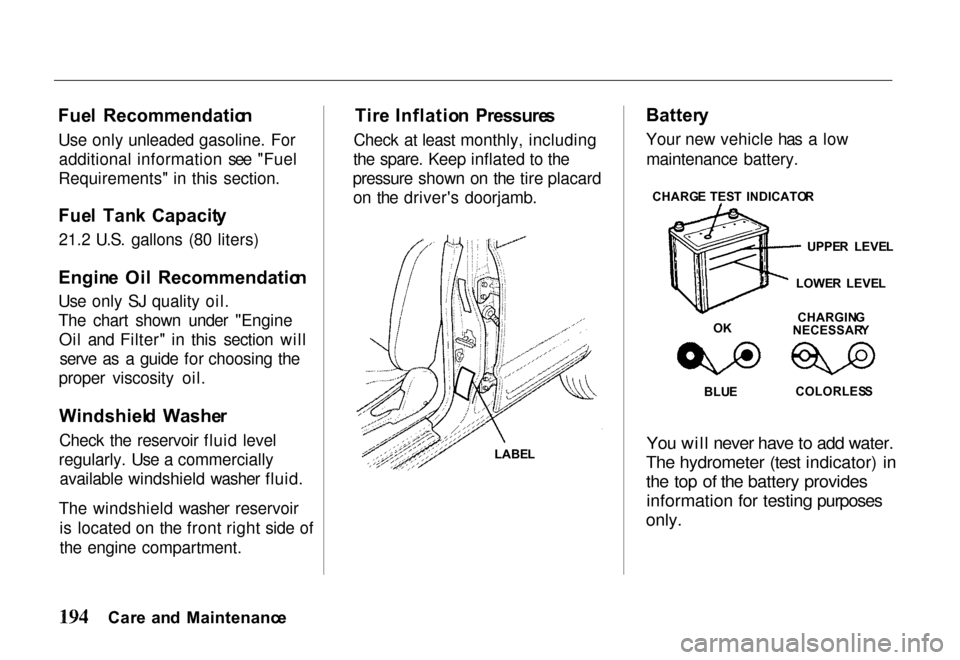Page 171 of 267

Three-Wa
y Catalyti c Converte r
The three-way catalytic converter is an emissions control device
added to the exhaust system to
reduce exhaust gas pollutants. The
converter contains a ceramic material coated with noble metal
catalysts. To prevent contamination
of the catalysts, unleaded gasoline must be used. Unleaded gasoline
also reduces combustion chamber
deposits and exhaust system
corrosion.
The three-way catalytic converter requires the use of unleaded
gasoline. Use of leaded gasolinewill cause the converter to lose its
effectiveness.
T o Hel p Preven t Damag e
1. Keep your engine properly maintained. Engine
malfunctions involving the electrical, electronic fuel
injection or ignition systems
may result in unusually high
converter and exhaust system
temperatures. Do not keep
driving your vehicle if you
detect engine misfire,
noticeable loss of performance, or other unusual operating
conditions. Have it serviced
promptly. A properly
maintained engine willminimize malfunctions that
could damage the converter. It
will also help provide good
emissions control and fuel economy. (See theMaintenance Schedule on page
200 for information on inspecting and maintaining the
engine, exhaust system and
other components.) 2. Do not push or tow your
vehicle to start it. This could
damage the converter.
3. Do not park your vehicle over high grass, dry leaves or othercombustible materials. The
catalytic converter gets very
hot and could set fire to these materials.
Drivin g Tip s
Page 172 of 267

If you are planning to take your
Honda outside the U.S. or
Canada, contact the tourist
bureaus in the areas you will be
traveling in to find out about the availability of unleaded gasoline
with the proper octane rating.
If unleaded gasoline is not
available, be aware that using
leaded gasoline in your Honda
will affect performance and fuel
mileage, and damage its
emissions controls. It will no longer comply with U.S. and
Canadian emissions regulations,
and will be illegal to operate in
North America. To bring your
vehicle back into compliance will
require the replacement of several components, such as the oxygen sensor and the three-way catalyticconverter. These replacements
are not covered under warranty.
Accessorie
s & Modification s
Modifying your vehicle, or installing some non-Honda
accessories, can make your vehicle
unsafe. Before you make any
modifications or add any accessories, be sure to read the
following information.
Accessories
Your dealer has Genuine Honda
accessories that allow you to
personalize your vehicle. These accessories have been designed and
approved for your vehicle, and are
covered by warranty.
Non-Honda accessories are
usually designed for universal
applications. Although
aftermarket accessories may fit on
your vehicle, they may not meet
factory specifications, and could adversely affect your vehicle's
handling and stability. (See "Modifications" on the next page
for additional information.)
When properly installed, car
phones, alarms, two-way radios, and low-powered audio systems
should not interfere with your
vehicle's computer-controlled
Driving Tip s
Operatio
n i n
Foreig n Countrie s
Improper accessories or
modifications can affect
your vehicle's handling,
stability and performance,
and cause a crash in
which you can be hurt or killed.
Follow all instructions in
this owner's manual regarding accessories and
modifications.
Page 177 of 267

Traile
r Towin g
Your Honda vehicle is designed
for passenger and cargo transportation. With the proper
equipment installed, your vehicle
can also tow a trailer under certain
conditions, as detailed in this section. Be sure to read this entire
section and follow all
requirements.
Towing a trailer will have an
effect on handling, performance,
braking, durability and fuel
consumption.
Honda recommends that you do
not tow a trailer with a new Honda vehicle or one with a new
powertrain component (engine, transmission, differential) for the
first 500 miles. For your safety and the safety
of others, use equipment
specifically designed for your
vehicle. Improper towing
equipment and improper installation of same can cause
damage to your vehicle and may also result in personal injury.
Additional care and cautious
driving habits are essential to trailer towing.
Do not exceed 45 mph or the
posted towing speed limit, whichever is lower. Higher speed
may cause loss of vehicle control.
Drivin g Tip s
Improperly loading your
vehicle and trailer can seriously affect the steering
and braking performance,
causing a crash in which you
can be seriously injured.
Check the loading of your
vehicle and trailer carefully before starting to drive.
Page 194 of 267

Car
e an d Maintenanc e
This section explains why it is important to keep your vehicle
well maintained and to follow
basic maintenance safety
precautions.
This section also includes Maintenance Schedules for
normal driving and severe driving
conditions, a Maintenance
Record, and instructions for simple maintenance tasks you
may want to take care of yourself.
If you have the skills and tools
required to perform more complex
maintenance tasks on your Honda,
you may want to purchase the Service Manual. See page 249 for
information on how to obtain a
copy, or see your Honda dealer. Service Station Information . 193
Fuel Fill Cap .......... 193Fuel Recommendation ... 194
Fuel Tank Capacity ..... 194
Engine Oil Recommendation ...... 194
Windshield Washer ..... 194
Tire Inflation Pressures .. 194 Battery ............... 194
Hood Release .......... 195
Engine Oil Dipstick ..... 196
Fuel Requirements ........ 196 Oxygenated Fuels ...... 196
Maintenance Safety ....... 197 Important Safety
Precautions .......... 198
Maintenance Schedule ..... 199
Required Maintenance Record 202
Owner Safety Checks ...... 204
Engine Oil and Filter ...... 207 Proper Quality Oil ...... 207 Change Interval ........ 207
Oil
Change ........... 208
Oil Filter Installation . 208
Oil Viscosity .......... 209
Oil Level Check ....... 209
Engine Oil Additives ... 210
Air Cleaner Filter ........ 210
Manual Transmission Fluid 211
Automatic Transmission Fluid .................. 212
Front (4WD) and Rear Axles ............. 212
Engine Cooling System ... 213
Other Required Maintenance 215 Brake Master Cylinder . . 215
Shift-on-the-Fly System
. 216
Front Whee
l Bearings ... 216
Hood Latch and Hinges . 217
Air Conditioning ....... 217 Body Lubrication ...... 217
Car e an d Maintenanc e
Page 195 of 267

Front (4WD Only) and
Rear Propeller Shaft ... 218
Exhaust System ....... 218 Fuel Line and Fuel Tank/Cap ............ 218
Drive Belt ............ 218
Timing Belt ........... 218 Valve Clearance ........ 218SparkPlugs ........... 219
Clutch ............... 219
Fluid or Lubricant Levels 219
Power Steering ........ 219 Accelerator Pedal Linkage 220
Wheel Alignment ...... 220
Exterior ................ 220 Washing Your Vehicle . . 220
Polishing and Waxing Your Vehicle ......... 220
Protection of Exterior Bright Metal Parts ..... 220
Care of Aluminum Wheels 220 Foreign Material Deposits 220
Finish Damage ........ 221
Corrosion Protection .... 221
Sheet Metal Damage .... 221
Underbody Maintenance 221
Interior ................ 222 Basic StepsBefore Cleaning ...... 222
Cleaning Fabric ........ 223 Cleaning General Soilageor Water Spots From
Fabric Trim ........ 223
Spot Cleaning Fabric With Solvent Cleaner 223
Removal of Specific Stains ...... 224
Cleaning Vinyl or Leather Trim ....... 225
Seat Belt Care ......... 225
Cleaning Glass Surfaces . 226
Car e an d Maintenanc e
Page 196 of 267
Servic
e Statio n Informatio n
Fuel Fil l Ca p
To remove the fuel fill cap, turn it counterclockwise. To close the fill
cap, turn it clockwise until you
hear it click at least three times.
Put the fuel fill cap in the cap
holder while refueling.
If you need a replacement, use only a genuine Honda fuel fill cap. An
improper fuel fill cap can affect the
fuel system, the emissions system,
and allow fuel spillage.
Car e an d Maintenanc e
Componen t Location s
ENGIN E
OI
L
FILLE R CA P CLUTC
H MASTE R
CYLINDE R
RESERVOI R
POWE R
STEERIN G
RESERVOI R
ENGIN
E
OI L DIPSTIC K
BRAKE MASTE R
CYLINDE R
RESERVOI R
WINDSHIEL
D
WASHE R
RESERVOI R
BATTER Y
RADIATO R
RESERV E
TAN K
RADIATO
R CA P
AIR CLEANE R
Page 197 of 267

Fue
l Recommendatio n
Use only unleaded gasoline. For additional information see "Fuel
Requirements" in this section.
Fue l Tan k Capacit y
21.2 U.S. gallons (80 liters)
Engin e Oi l Recommendatio n
Use only SJ quality oil.
The chart shown under "Engine Oil and Filter" in this section willserve as a guide for choosing the
proper viscosity oil.
Windshiel d Washe r
Check the reservoir fluid level
regularly. Use a commercially available windshield washer fluid.
The windshield washer reservoir is located on the front right side of
the engine compartment. Tir
e Inflatio n Pressure s
Check at least monthly, including
the spare. Keep inflated to the
pressure shown on the tire placard on the driver's doorjamb. Batter
y
Your new vehicle has a low maintenance battery.
You will never have to add water.
The hydrometer (test indicator) in
the top of the battery provides information for testing purposes
only.
Car e an d Maintenanc e LABE
L CHARG
E TES T INDICATO R
UPPE R LEVE L
LOWE R LEVE L
CHARGIN G
NECESSAR Y
BLU E COLORLES
S
O
K
Page 199 of 267

To Close
1. Lift the hood slightly to remove tension from the support rod.
2. Place the support rod in its retaining clip and lower the
hood.
Always make sure the hood is securely latched before you begin
driving.
Engin
e Oi l Dipstic k
Check the oil level when the
engine is off and the oil is warm, such as during a fuel stop. See
page 209. Your Honda operates most
effectively on unleaded gasoline with a pump octane number of 86
or higher. Use of a lower octane
gasoline can cause a persistent, heavy metallic rapping noise in
the engine that can lead to
mechanical damage.
We recommend gasolines containing
detergent additives that help prevent
fuel system and engine deposits.
Using gasoline containing lead will
damage your vehicle's emission
controls. This contributes to air
pollution and can void certain parts
of your warranty.
Oxygenate d Fuel s
Some conventional gasolines are
being blended with alcohol or an
ether compound. These gasolines are collectively referred to as
oxygenated fuels. To meet clean air
Car e an d Maintenanc e
Fue
l Requirement s